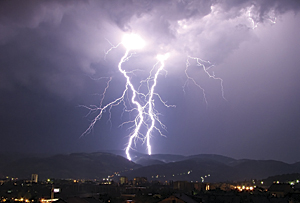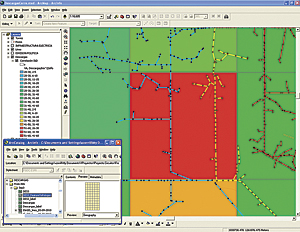Colombian Oil and Gas Companies Outrun Lightning with Better Electric Network Design
Highlights
- A grid within the GIS records the lightning's extent, count, and average amplitude per square mile.
- Visualizing lightning data with GIS helps grow understanding of pole design features.
- Managing the grid with GIS allows maintenance prioritization.
At the La Circa Infantas petrol field in El Centro, Santander, Colombia, lightning is a major problem. Colombia ranks second to the Democratic Republic of the Congo in annual lightning strikes, according to NASA's Global Hydrology and Climate Center. In the past two years, La Circa Infantas alone attracted 30,000 lightning strikes.
"Lightning affects our electrical distribution network, which feeds the engines that operate the wells, causing the terrible effects of production loss, equipment damage, and uncertainty in the network design," says Luis Alejandro Zorrilla, an electrical engineer with Occidental Oil & Gas.
Occidental operates La Circa Infantas through a joint venture contract with Ecopetrol S.A. La Circa Infantas was the first petrol field in Colombia, with its first well, Infantas 2, completed in April 1918.
"This historic field has all the great challenges of a field built by many companies," Zorrilla adds.
The oil field's electric distribution network is made up of 3,000 poles, about 300 miles of electric line, and 1,000 engines. After more than 90 years in operation and many changes in management, the electric network was suffering huge inefficiencies. Data was duplicated, incomplete, old, or inaccurate.
Complicating matters was the fact that the electric infrastructure undergoes daily changes, with new lines and poles and new electric and communication equipment due to new wells. The whole process demands planning, design, connection, and reporting—a set of tasks highly dependent on accurate data.
By contrast, the information about the wells—their geographic location, maintenance history, construction date, and more—was concentrated in a GIS.
"The well GIS helps our team develop all our engineering activities. We saw a need to build a GIS for the electric network as well," Zorrilla says. "Our first step in developing an electric network GIS was to spatially enable the information related to the load on our electric network."
Next, the team created a data model that reflected the entire workflow, from workforce to energy management. The data required in the workflow was described in the data model.
Once the data model was constructed, the distribution network inspection project began. The goal was to update and unify all geodata available. With a geodataset in hand, workers modeled the electrical GIS geodatabase and developed the system in ArcGIS.
Improving the Design
 Electric network pole designs were fashioned based on average annual lightning density and current amplitude data. The designs were researched and studied. Nevertheless, every lightning storm managed to identify faults in the design. Zorrilla reported approximately 600 faults in the distribution network circuits that feed the field in one year.
Electric network pole designs were fashioned based on average annual lightning density and current amplitude data. The designs were researched and studied. Nevertheless, every lightning storm managed to identify faults in the design. Zorrilla reported approximately 600 faults in the distribution network circuits that feed the field in one year.
"The questions were obvious," Zorrilla says. "Why are the designs failing? How can we improve the designs?"
When the engineers took a closer look at the annual fault data, a clue emerged. About 90 percent of the failures were caused by lightning discharges and flashovers. The shielding angle did not protect the lines. They would need a more specific and accurate measurement of the lightning density and current amplitude.
Colombia's national lightning data system has 50 sensors to determine the location and electric characteristics of lightning. La Circa Infantas' energy management department requested this data. The electrical studies department developed a grid within the GIS to record the lightning's extent, count, and average amplitude per square mile.
"When we overlapped the electrical GIS with the lightning density and current amplitude grid, we saw an amazing relationship between the failures and the critical areas," Zorrilla explains. "The lightning data visualized as a grid, with the correlation of the two variables—density and current amplitude per square mile—helps locally understand why the pole designs failed."
With the help of the grid and the electrical GIS that was built on ArcGIS, engineers can approach every pole design according to the pole's location and its consistency with the geodataset. The grid is colored on a blue-to-red scale, with red signifying critical. An additional benefit is that engineers can prioritize the correction of the designs and plan maintenance based on the critical areas.
"A deep understanding of the lightning situation is now available," Zorrilla says. "Better decisions are being made. Design can now be standardized, depending on pole location and similar features, in lieu of a unique design for each pole."
Now that the electrical GIS is established and integrated with other corporate systems, La Circa Infantas is enjoying the benefits. New geoapplications, such as the grid, are under way. And, there is a boost in overall performance of the energy management department's daily work.
For more information, contact Luis Zorrilla, electrical engineer, Occidental Oil & Gas (e-mail: Alejandro_zorrilla@oxy.com).
